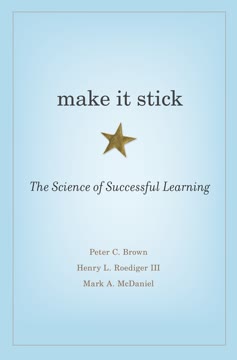Key Takeaways
1. Understand Your Brain's Focused and Diffuse Modes
Your brain works in two different ways. We'll call these two ways of working the focused mode and the diffuse mode.
Focused mode is when you're actively concentrating on a task, like solving a math problem or listening to your teacher. Your brain uses specific neural pathways to process information. Diffuse mode occurs when your mind is relaxed and free, such as when you're daydreaming or doodling. This mode allows for more creative connections between ideas.
To learn effectively, you need to alternate between these two modes:
- Use focused mode for intense concentration and initial learning
- Switch to diffuse mode to allow your brain to make broader connections
- Employ techniques like the "picture walk" to prepare your brain for focused learning
- Take breaks to activate diffuse mode, which can help solve problems and generate new ideas
2. Combat Procrastination with the Pomodoro Technique
Just get going. Don't put work off until later.
Overcome procrastination by using the Pomodoro Technique, a time management method developed by Francesco Cirillo. This technique helps you focus intensely for short periods and take regular breaks.
How to use the Pomodoro Technique:
- Set a timer for 25 minutes
- Work focused on a single task until the timer rings
- Take a 5-minute break
- Repeat the process
- After four pomodoros, take a longer break (15-30 minutes)
Benefits of the Pomodoro Technique:
- Reduces the pain of getting started
- Builds focus and concentration skills
- Provides a sense of accomplishment
- Allows for regular diffuse mode breaks
3. Create Strong Brain-Links Through Practice and Sleep
A set of brain-links is a pathway of connected neurons in your long-term "locker" memory that is built through practice.
Build neural connections by practicing regularly and allowing your brain to consolidate information during sleep. Strong brain-links make it easier to recall and use information.
Key aspects of creating strong brain-links:
- Active practice: Engage with the material through problem-solving, writing, or teaching others
- Spaced repetition: Review information at increasing intervals over time
- Sleep: Allow your brain to strengthen neural connections during rest
- Deliberate practice: Focus on challenging aspects of the material
- Interleaving: Mix different topics or skills within a practice session
Remember that building strong brain-links takes time and consistent effort. Be patient with yourself and trust the process of learning and consolidation.
4. Leverage Memory Techniques to Enhance Learning
If you convert a fact you are trying to remember into a picture, you can remember it more easily. If the picture is unusual, it's even easier to remember.
Improve your memory by using techniques that leverage your brain's natural ability to remember visual and spatial information. These methods can help you retain and recall complex information more easily.
Effective memory techniques:
- Memory palace: Associate information with specific locations in a familiar place
- Vivid imagery: Create unusual, memorable images to represent facts or concepts
- Acronyms and mnemonics: Develop catchy phrases or word associations
- Chunking: Group related information into larger, meaningful units
- Mind mapping: Create visual diagrams to show relationships between ideas
By transforming abstract information into concrete, visual representations, you can significantly enhance your ability to remember and understand complex subjects.
5. Harness the Power of Metaphors and Active Recall
Metaphors allow you to connect what you already know to the new concept you're learning. This helps you learn faster.
Use metaphors and active recall to deepen your understanding and strengthen your memory of new concepts. Metaphors help you relate new information to familiar ideas, while active recall reinforces neural pathways.
Strategies for effective learning:
- Create metaphors: Compare new concepts to familiar objects or experiences
- Use analogies: Draw parallels between different subjects or ideas
- Practice active recall: Regularly test yourself on the material without looking at notes
- Teach others: Explain concepts in your own words to reinforce understanding
- Write summaries: Condense information into your own words after studying
By actively engaging with the material and connecting it to existing knowledge, you'll build stronger, more flexible neural networks that enhance both comprehension and retention.
6. Embrace Deliberate Practice and Interleaving
Deliberate practice means focusing on the material that's most difficult for you. The opposite is "lazy learning"—repeatedly practicing what's easiest.
Improve your learning efficiency by incorporating deliberate practice and interleaving into your study routine. These techniques help you tackle challenging material and develop a more comprehensive understanding of the subject.
Key aspects of effective practice:
- Deliberate practice: Focus on areas where you struggle the most
- Interleaving: Mix different topics or skills within a single study session
- Spaced repetition: Review material at increasing intervals over time
- Active engagement: Solve problems, write explanations, or teach concepts to others
- Feedback: Seek input from teachers, peers, or self-assessment to identify areas for improvement
By challenging yourself with varied and difficult material, you'll develop a deeper understanding and more flexible knowledge that can be applied in different contexts.
7. Optimize Your Study Environment and Habits
Study in different places when you can. This allows your attentional octopus to be comfortable when it takes a test in a room that's not the one you studied in.
Create an effective learning environment by considering factors that impact your focus, memory, and overall cognitive performance. Small changes in your study habits can lead to significant improvements in learning outcomes.
Tips for optimizing your study environment and habits:
- Vary study locations to improve recall in different contexts
- Minimize distractions, including background noise and digital devices
- Use appropriate lighting and comfortable seating
- Take regular breaks to maintain focus and engage diffuse mode thinking
- Incorporate physical exercise to boost brain function and memory
- Get adequate sleep to consolidate learning and clear mental toxins
- Stay hydrated and maintain a balanced diet for optimal brain function
By creating an environment that supports focused attention and healthy cognitive function, you'll maximize your learning potential and retention of information.
8. Develop a Growth Mindset and Broaden Your Passions
Learn how to learn so you can follow your passions. But don't just follow your passions. That was my mistake when I was young. There's a lot of learning you can do that will open doors you can't yet imagine.
Cultivate a growth mindset and explore diverse interests to enhance your learning potential and adaptability. Recognize that intelligence and abilities can be developed through effort and practice.
Strategies for personal growth and learning:
- Embrace challenges as opportunities for growth
- View mistakes and failures as valuable learning experiences
- Seek out new subjects and skills beyond your comfort zone
- Cultivate curiosity and ask questions
- Develop a love for learning itself, not just specific subjects
- Connect ideas from different fields to enhance creativity and problem-solving
- Be patient with yourself and celebrate small victories in the learning process
By adopting a growth mindset and broadening your interests, you'll become a more flexible, creative learner capable of adapting to new challenges and opportunities throughout your life.
Last updated:
FAQ
What's "Learning How to Learn" about?
- Target Audience: The book is designed for kids and teens, but adults can also find valuable insights. It aims to teach effective learning strategies.
- Core Focus: It explains how understanding a bit about how the brain works can make learning more fun and less frustrating.
- Authors' Background: Written by Barbara Oakley, Terrence Sejnowski, and Alistair McConville, it combines neuroscience with practical advice.
- Learning Techniques: The book introduces various techniques to improve memory, manage time, and enhance learning efficiency.
Why should I read "Learning How to Learn"?
- Improve Learning Skills: It offers strategies to help you learn more effectively without spending all your time studying.
- Scientific Basis: The advice is grounded in neuroscience, providing a scientific understanding of how learning works.
- Practical Tips: The book is filled with practical tips and exercises that can be applied to any subject or skill.
- Engaging Content: Written in an engaging and accessible style, it makes complex concepts understandable and entertaining.
What are the key takeaways of "Learning How to Learn"?
- Focused and Diffuse Modes: Understanding the two modes of thinking can help optimize learning and problem-solving.
- Pomodoro Technique: This time management method helps combat procrastination and improve focus.
- Active Recall: Actively recalling information strengthens memory and understanding.
- Interleaving Practice: Mixing different types of problems or subjects enhances learning and adaptability.
How does the Pomodoro Technique work according to the book?
- Set a Timer: Work for 25 minutes without distractions, focusing solely on the task at hand.
- Take a Break: After the timer goes off, take a 5-10 minute break to relax and let your brain rest.
- Reward Yourself: Use the break as a reward, which can help reinforce the habit of focused work.
- Repeat the Cycle: Continue the cycle to maintain productivity and prevent burnout.
What is the significance of "Focused and Diffuse Modes" in learning?
- Focused Mode: This mode is used for concentrated, detailed work, like solving a math problem or reading.
- Diffuse Mode: This mode is more relaxed and allows for creative thinking and problem-solving.
- Switching Modes: Alternating between these modes can help overcome mental blocks and enhance understanding.
- Practical Application: Recognizing when to use each mode can improve study habits and learning outcomes.
How does "Active Recall" enhance learning?
- Memory Strengthening: Actively recalling information helps to reinforce memory and understanding.
- Engagement: It requires active engagement with the material, which leads to better retention.
- Practical Use: Techniques like self-quizzing and teaching others can be effective forms of active recall.
- Research Support: Studies show that active recall is more effective than passive review methods like rereading.
What role does sleep play in learning according to "Learning How to Learn"?
- Memory Consolidation: Sleep helps solidify new information by strengthening synaptic connections.
- Brain Detoxification: It clears toxins from the brain, which can improve cognitive function.
- Learning Enhancement: Adequate sleep is crucial for effective learning and problem-solving.
- Practical Advice: The book suggests getting consistent, quality sleep to maximize learning potential.
How can "Interleaving Practice" improve learning?
- Variety in Practice: Interleaving involves mixing different types of problems or subjects during study sessions.
- Enhanced Adaptability: It helps learners adapt to new situations by practicing switching between different tasks.
- Better Retention: This method improves retention by forcing the brain to constantly retrieve and apply different strategies.
- Practical Implementation: Incorporate interleaving by alternating between topics or types of problems in study sessions.
What are some of the best quotes from "Learning How to Learn" and what do they mean?
- "Brains are amazing. They’re the most sophisticated gadgets in the universe." This highlights the incredible potential of the human brain and the importance of understanding how it works.
- "Lady Luck favors the one who tries." This encourages persistence and effort in learning, suggesting that success often comes to those who keep trying.
- "Eat your frogs first." This means tackling the most challenging tasks first to get them out of the way and make the rest of the work easier.
- "Learning how to learn will make your years in school more fun and less frustrating." This emphasizes the book's core message that effective learning strategies can transform the educational experience.
How does the book suggest dealing with procrastination?
- Understanding Pain: Recognize that procrastination is often a response to the discomfort of starting a task.
- Pomodoro Technique: Use this method to break tasks into manageable chunks and reduce the urge to procrastinate.
- Friendly Zombies: Develop good habits (or "zombies") that automatically guide you to start tasks without overthinking.
- Reward System: Implement a reward system to make starting tasks more appealing and less daunting.
What is the "Memory Palace" technique mentioned in the book?
- Visualization: Imagine a familiar place and mentally place items you want to remember in specific locations.
- Association: Create vivid, memorable images for each item to enhance recall.
- Retrieval Practice: Walk through your memory palace in your mind to retrieve the information.
- Historical Use: This ancient technique has been used for centuries to improve memory and recall.
How does "Learning How to Learn" address different learning styles?
- Multisensory Learning: The book suggests using multiple senses to enhance learning, rather than relying on a single "preferred" style.
- Research Findings: Studies indicate that using various senses can improve understanding and retention.
- Practical Application: Incorporate visual, auditory, and kinesthetic elements into study sessions for a more comprehensive learning experience.
- Avoiding Limitations: By not limiting oneself to a single style, learners can become more adaptable and effective.
Review Summary
Learning How to Learn offers practical techniques for effective learning, backed by neuroscience. Readers praise its accessible explanations, useful metaphors, and concrete exercises. Many wish they had read it earlier in their education. The book covers topics like focus, memory, procrastination, and sleep. While aimed at younger readers, adults find it valuable too. Reviewers appreciate the scientific basis and real-world applicability. Some note it simplifies concepts from more advanced books on learning, making it an excellent starting point for students and lifelong learners alike.
Similar Books






Download PDF
Download EPUB
.epub digital book format is ideal for reading ebooks on phones, tablets, and e-readers.








